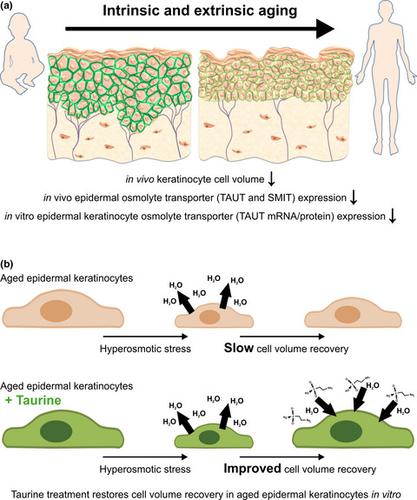当前位置:
X-MOL 学术
›
Aging Cell
›
论文详情
Our official English website, www.x-mol.net, welcomes your
feedback! (Note: you will need to create a separate account there.)
Osmolyte transporter expression is reduced in photoaged human skin: Implications for skin hydration in aging.
Aging Cell ( IF 8.0 ) Pub Date : 2019-11-26 , DOI: 10.1111/acel.13058 April R Foster 1 , Cecile El Chami 1 , Catherine A O'Neill 1 , Rachel E B Watson 1, 2
Aging Cell ( IF 8.0 ) Pub Date : 2019-11-26 , DOI: 10.1111/acel.13058 April R Foster 1 , Cecile El Chami 1 , Catherine A O'Neill 1 , Rachel E B Watson 1, 2
Affiliation

|
Aging is characterized by the deterioration of tissue structure and function. In skin, environmental factors, for example, ultraviolet radiation (UVR), can accelerate the effects of aging such as decline in barrier function and subsequent loss of hydration. Water homeostasis is vital for all cellular functions and it is known that organic osmolyte transport is critical to this process. Therefore, we hypothesized that as we age, these tightly controlled physiological mechanisms become disrupted, possibly due to loss of transporter expression. We investigated this in vivo, using human skin samples from photoprotected and photoexposed sites of young and aged volunteers. We show a reduction in keratinocyte cell size with age and a downregulation of osmolyte transporters SMIT and TAUT with both chronic and acute UVR exposure. Single‐cell live imaging demonstrated that aged keratinocytes lack efficient cell volume recovery mechanisms possessed by young keratinocytes following physiological stress. However, addition of exogenous taurine significantly rescued cell volume; this was corroborated by a reduction in TAUT mRNA and protein in aged, as compared to young, keratinocytes. Collectively, these novel data demonstrate that human epidermal keratinocytes possess osmolyte‐mediated cell volume regulatory mechanisms, which may be compromised in aging. Therefore, this suggests that organic osmolytes—especially taurine—play a critical role in cutaneous age‐related xerosis and highlights a fundamental mechanism, vital to our understanding of the pathophysiology of skin aging.
中文翻译:

渗透光的转运蛋白表达在光老化的人类皮肤中降低:对衰老过程中皮肤水合作用的影响。
衰老的特征在于组织结构和功能的恶化。在皮肤中,环境因素,例如紫外线(UVR),会加速衰老的影响,例如屏障功能下降和随后的水合作用丧失。水的动态平衡对于所有细胞功能都至关重要,众所周知,有机渗透液的运输对这一过程至关重要。因此,我们假设随着年龄的增长,这些严格控制的生理机制可能会被破坏,这可能是由于转运蛋白表达的丧失。我们使用来自年轻人和老年志愿者的受光保护和受光照射部位的人体皮肤样品对此进行了体内研究。我们显示,随着年龄的增长,角质形成细胞的大小会减少,渗透压转运蛋白SMIT和TAUT会随着慢性和急性UVR暴露而下调。单细胞实时成像表明,老化的角质形成细胞缺乏生理应激后年轻角质形成细胞具有的有效细胞体积恢复机制。但是,添加外源性牛磺酸可显着拯救细胞体积。与年轻的角质形成细胞相比,老年TAUT mRNA和蛋白质的减少证实了这一点。总的来说,这些新数据表明,人类表皮角质形成细胞具有渗透压介导的细胞体积调节机制,这可能会在衰老过程中受到损害。因此,这表明有机渗透物,尤其是牛磺酸,在与皮肤衰老有关的干燥症中起着关键作用,并突显了一种基本机制,对于我们对皮肤衰老的病理生理学的理解至关重要。
更新日期:2019-11-26
中文翻译:

渗透光的转运蛋白表达在光老化的人类皮肤中降低:对衰老过程中皮肤水合作用的影响。
衰老的特征在于组织结构和功能的恶化。在皮肤中,环境因素,例如紫外线(UVR),会加速衰老的影响,例如屏障功能下降和随后的水合作用丧失。水的动态平衡对于所有细胞功能都至关重要,众所周知,有机渗透液的运输对这一过程至关重要。因此,我们假设随着年龄的增长,这些严格控制的生理机制可能会被破坏,这可能是由于转运蛋白表达的丧失。我们使用来自年轻人和老年志愿者的受光保护和受光照射部位的人体皮肤样品对此进行了体内研究。我们显示,随着年龄的增长,角质形成细胞的大小会减少,渗透压转运蛋白SMIT和TAUT会随着慢性和急性UVR暴露而下调。单细胞实时成像表明,老化的角质形成细胞缺乏生理应激后年轻角质形成细胞具有的有效细胞体积恢复机制。但是,添加外源性牛磺酸可显着拯救细胞体积。与年轻的角质形成细胞相比,老年TAUT mRNA和蛋白质的减少证实了这一点。总的来说,这些新数据表明,人类表皮角质形成细胞具有渗透压介导的细胞体积调节机制,这可能会在衰老过程中受到损害。因此,这表明有机渗透物,尤其是牛磺酸,在与皮肤衰老有关的干燥症中起着关键作用,并突显了一种基本机制,对于我们对皮肤衰老的病理生理学的理解至关重要。











































 京公网安备 11010802027423号
京公网安备 11010802027423号